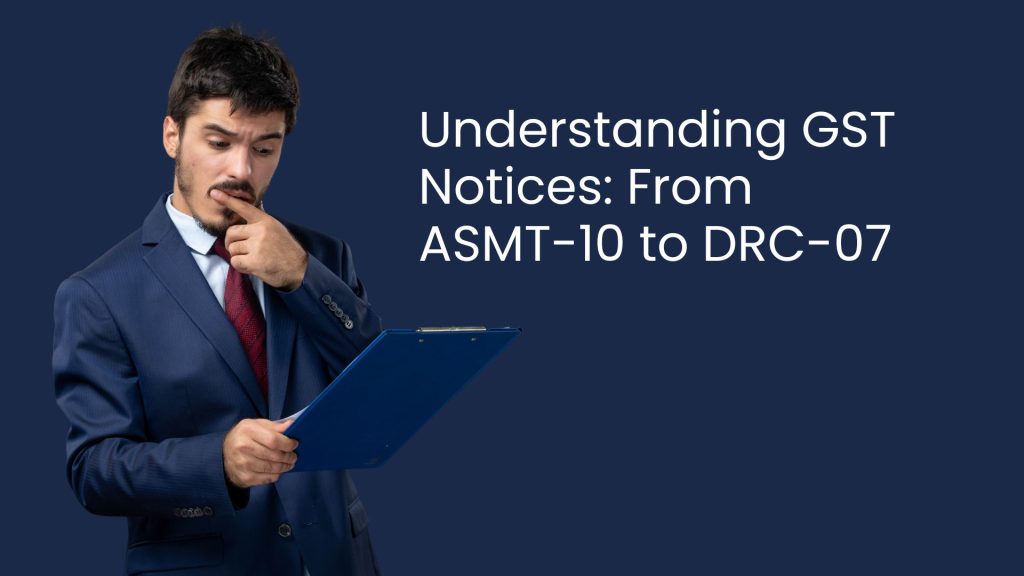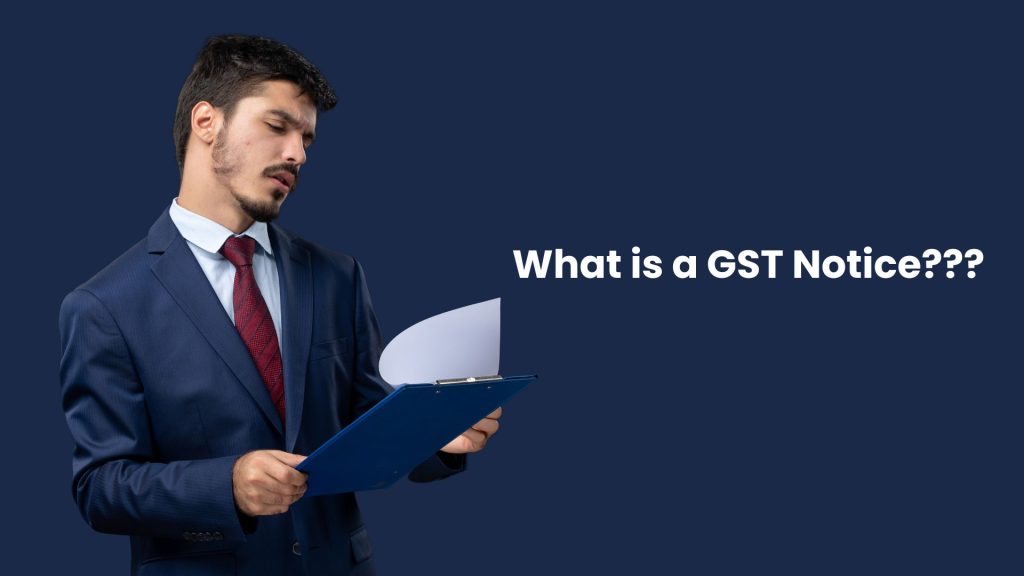
As a business registered under GST, receiving a notice from the GST Department can be intimidating. Many businesses panic when they receive an email or message from the GST portal with terms like ASMT-10, DRC-01, or DRC-07 — but in reality, most of these notices are part of a structured process followed by the tax department.
In this article, we’ll explain what each GST notice means, why it is issued, and how to respond effectively — so you can protect your business and avoid unnecessary penalties.
1. What is a GST Notice?

Under the GST law, officers can issue notices for various reasons such as:
- Mismatch between GSTR-1, GSTR-3B, and GSTR-2A/2B
- Non-filing or delayed filing of returns
- Excess claim of Input Tax Credit (ITC)
- Short payment or non-payment of tax
- Wrong classification of supply
- Fake or cancelled vendor invoices
- Discrepancies found during scrutiny or audit
Each type of notice serves a specific purpose — and understanding the sequence helps you respond properly.
2. The Flow of Notices: From ASMT-10 to DRC-07
When discrepancies are found, the GST Department generally follows a step-by-step escalation process before creating a demand.
Here’s how it typically flows:
Step 1: ASMT-10 — Notice for Discrepancies in Returns
Form ASMT-10 is the first stage notice in the scrutiny process.

Purpose:
Issued when the department finds discrepancies between the returns filed (like GSTR-1, GSTR-3B, GSTR-9, etc.) or between return data and other information available with the department (for example, e-way bill or 2A/2B mismatch).
Example of Triggers:
- GSTR-3B turnover is less than GSTR-1
- ITC claimed in GSTR-3B is more than GSTR-2B
- Output tax liability not matching with annual return
- GSTR-3B filed but payment not made
Action Required:
You are required to reply in Form ASMT-11 within the prescribed time (usually 15 days) explaining the discrepancy with proper documentation.
If Ignored:
If you fail to reply or the reply is unsatisfactory, the officer may move to demand and recovery proceedings.
Step 2: DRC-01 — Show Cause Notice (SCN) under Section 73 or 74
If discrepancies remain unresolved, the department issues a Show Cause Notice in Form DRC-01.

Purpose:
To ask the taxpayer to explain why tax, interest, and penalty should not be demanded under: Section 73 (non-fraud cases), or | Section 74 (fraud or suppression cases).
Key Points:
- The notice mentions the exact period, amount involved, and grounds for demand.
- It allows the taxpayer to reply in Form DRC-06.
- In many cases, a summary of the SCN is also uploaded in DRC-01A (optional pre-SCN communication).
Typical Issues:
- ITC claimed from cancelled or return-defaulting dealers
- GSTR-1 and GSTR-3B mismatch
- Wrong classification of goods/services
- Difference between GSTR-9 and audited books
Action Required:
Prepare a detailed reply in Form DRC-06, supported by reconciliations, invoices, payment proofs, and legal references.
A strong, evidence-backed reply often helps in closing the case at this stage itself.
Step 3: DRC-03 — Voluntary Payment (If Any Discrepancy Accepted)
Sometimes, upon reviewing the notice, the taxpayer may realize that a part of the discrepancy is valid.

Purpose:
Form DRC-03 allows you to make voluntary payment of tax, interest, or penalty — either before or after receiving the notice.
Advantage:
If payment is made before issuance of DRC-01 (i.e., during ASMT-10 stage), penalty can often be avoided.
Even after DRC-01, paying voluntarily before final order can reduce penalty exposure.
Step 4: DRC-07 — Final Order and Demand Notice
If the officer finds your reply unsatisfactory or you don’t respond at all, the department issues a final order in Form DRC-07.

Purpose:
To create a formal tax demand against you. It specifies:
- Final tax, interest, and penalty amount
- Period covered
- Relevant sections invoked
- Date of order
Effect:
The amount mentioned in DRC-07 becomes recoverable under GST law — and will appear in your Electronic Liability Ledger.
If you disagree with the order, you can file an appeal in Form GST APL-01 to the Appellate Authority within 3 months.
3. Step-by-Step Example: How It Typically Happens
Let’s understand with a practical example:
Example:
A company’s GSTR-3B shows ITC claim of ₹25 lakh, but GSTR-2B shows only ₹20 lakh available.
- Department issues ASMT-10 highlighting a ₹5 lakh difference.
- The company replies via ASMT-11 explaining that ₹3 lakh was on invoices appearing later and ₹2 lakh was reversed in next month.
- Officer is not satisfied and issues DRC-01 proposing a demand of ₹5 lakh + interest.
- Company pays ₹2 lakh via DRC-03 voluntarily and defends the rest through DRC-06 reply.
- Officer still confirms demand for ₹3 lakh and issues final DRC-07.
- Company can now appeal the order if grounds are strong.
4. Key Timelines You Should Remember
| Form | Purpose | Action by Taxpayer | Typical Time Limit |
|---|---|---|---|
| ASMT-10 | Scrutiny notice | Reply in ASMT-11 | Within 15 days |
| DRC-01 | Show Cause Notice | Reply in DRC-06 | Within 30 days (or as mentioned) |
| DRC-03 | Voluntary payment | Optional | Anytime before order |
| DRC-07 | Final Order | Appeal in APL-01 | Within 3 months |
5. How to Respond Effectively to GST Notices
Many businesses lose cases not because they are wrong — but because their replies are incomplete or unprofessional.
Here’s how to respond effectively:
- Read the notice carefully — note the period, section, and discrepancies mentioned.
- Gather all documents — invoices, reconciliation reports, payment proofs, correspondence, etc.
- Compare data from GSTR-1, 3B, 2B, and books of accounts.
- Prepare a point-wise reply — addressing each allegation with facts and supporting evidence.
- Submit the reply online in the correct form (ASMT-11 or DRC-06).
- Keep acknowledgement proof of submission for records.
6. Common Mistakes Businesses Make
- Ignoring ASMT-10 thinking it’s just a routine query
- Relying on accountants to handle notices without expert review
- Filing incomplete or unsubstantiated replies
- Missing reply deadlines
- Paying under pressure without verifying facts
- Not filing appeal even when the order is unjustified
A professional, well-drafted reply can prevent escalation to DRC-07 and save significant tax, interest, and penalty.
How Vizttax Helps

At Vizttax, we specialize in GST litigation and departmental representation.
Our experts have handled multiple cases where notices were issued for ITC mismatch, cancelled suppliers, and turnover discrepancies.
We help you with:
- Review of notice and risk assessment
- Preparation of reconciliation and documentary evidence
- Drafting and submission of detailed reply
- Representation before department
- Filing of appeal against DRC-07, if required
Our goal is simple — protect your rightful ITC and reduce tax exposure legally.
Conclusion
Receiving a GST notice doesn’t mean you’ve done something wrong — it’s often part of routine scrutiny. What matters is how quickly and accurately you respond.
Understanding the process — from ASMT-10 to DRC-07 — helps you stay calm, informed, and compliant.
With professional guidance, most cases can be resolved at the initial stage itself, saving both time and money.
Update: Section 74A Introduced from FY 2024-25
Earlier, GST demand and recovery proceedings were governed by Section 73 (for non-fraud cases) and Section 74 (for fraud/suppression cases).
From FY 2024-25 onwards, a new Section 74A has been inserted in the CGST Act, replacing both Sections 73 and 74 for new cases.
Key Highlights of Section 74A:
- It provides a single unified framework for all types of tax demands — whether due to non-payment, short-payment, excess refund, or wrongly availed ITC.
- The earlier distinction between “fraud” and “non-fraud” cases is removed, but penalty slabs are still defined separately depending on intent.
- Notice must be issued within 42 months from the due date of annual return for the relevant financial year.
- Final order must be issued within 12 months from the date of the notice.
- Taxpayers can still make voluntary payment through DRC-03 before or after the notice to reduce penalty.
Effect on Businesses:
- The process flow — from ASMT-10 to DRC-07 — remains the same.
- Only the section reference and time limits change.
- For FY 2024-25 and later years, any SCN or demand will be issued under Section 74A, not under Section 73/74.

Therefore, when you receive a GST notice, you should first check:
Which financial year it relates to — that will decide whether Section 73/74 (old law) or Section 74A (new law) applies.
To understand the official formats and latest updates related to GST notices, you can also refer to the Central Board of Indirect Taxes and Customs (CBIC) official website.
